The World Stops When You Find Yourself Engrossed in Another Person’s Story
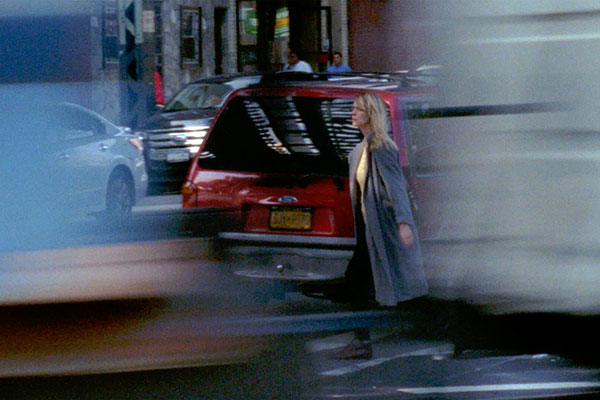
Image: Stephanie Hayes in Slow Machine
Yonca Talu
The World Stops When You Find Yourself Engrossed in Another Person’s Story
Interview with Paul Felten and Joe DeNardo
EVER since Paul Felten and Joe DeNardo’s debut feature Slow Machine premiered at the 2020 Rotterdam Film Festival, its various literary and cinematic references have been on critics’ lips. Written by Felten, then shot on 16mm and edited by DeNardo, the film pays particular tribute to late French auteur Jacques Rivette through its paranoid account of an adrenaline-seeking actress’ involvement with a mysterious NYPD intelligence agent. Achieving a rare formal sophistication despite its minimal budget, Slow Machine takes up some of Rivette’s favorite motifs—including the theater, conspiracies, and alternate realities—to offer a riveting examination of contemporary urban angst. Months after interviewing lead actress Stephanie Hayes for Metrograph’s Journal, I had a virtual sit-down with New York-based co-directors Felten and DeNardo to parse out Rivette’s influence on Slow Machine.
Yonca Talu: You’ve described Jacques Rivette as Slow Machine’s ‘‘inspirational godfather.’’ How did you first encounter his films?
Paul Felten: My memory is that we saw Céline and Julie Go Boating [1974] together at the Alliance Française [New York’s French Institute] in 2003. They were doing a Rivette retrospective with prints, so we went to see as many of his films as we could. I think it’s really important to watch them in the theater.
Joe DeNardo: Our friendship goes back to college and was forged by moviegoing. We saw a lot of films together for the first time, including Rivette’s. Céline and Julie Go Boating was a particularly refreshing viewing. I remember coming out of the theater elated, and being like, ‘‘Oh my God, what have we just seen?’’ It was so special—unlike anything we’d ever watched before.
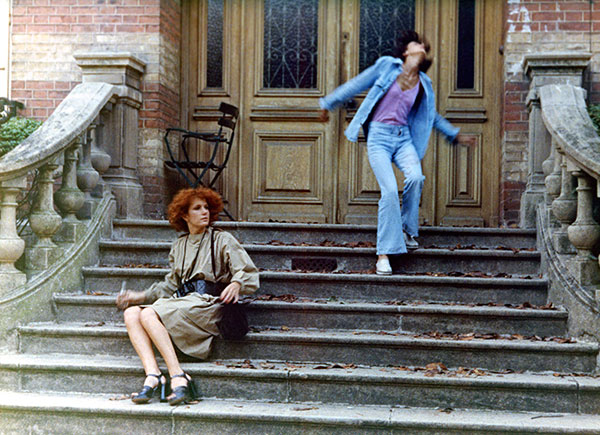 Dominique Labourier and Juliet Berto in Céline and Julie Go Boating (Les Films du Losange)
Dominique Labourier and Juliet Berto in Céline and Julie Go Boating (Les Films du Losange)
YT: Your reverence for Céline and Julie Go Boating is definitely palpable in Slow Machine. In fact, your protagonist, Stephanie, has a lot in common with Rivette’s titular heroines, including an addiction to fiction that prompts her to make up stories and take on different personas. How consciously did you draw from Céline and Julie while creating Stephanie?
PF: What I find most exciting about Céline and Julie is their mercuriality. That was somehow the first word that came to my mind when I was thinking about Stephanie. I wanted her to be capable of doing anything at any moment. That’s why I wrote the screenplay as a kind of improvised collage, without outlining it, and we started shooting before the final draft was even finished.
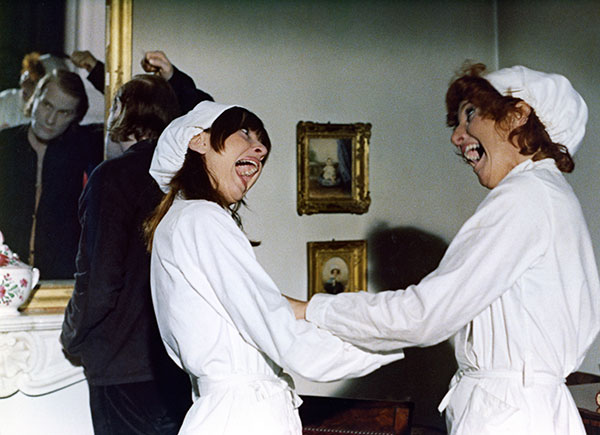
Barbet Schroeder, Juliet Berto, and Dominique Labourier in Céline and Julie Go Boating (Les Films du Losange)
YT: That sounds similar to Rivette’s own process of writing some of his films as they were being shot.
PF: Yeah. That spontaneous energy is so lacking from cinema today. Everything feels overmanaged and televisually bland.
YT: How did your interest in Rivette evolve over time? Did you also familiarize yourselves with his filmmaking methods?
PF: Rivette’s films weren’t widely distributed in America, and not much has been published about him in English, except for an out-of-print monograph by Jonathan Rosenbaum and two other short monographs. The best record of his practice is probably Claire Denis’ [1990] documentary, Jacques Rivette: The Night Watchman [which features Rivette in conversation with critic Serge Daney]. Although from what I can tell, he wasn’t so comfortable talking about his process.
JD: There was an interview where he mentioned his inability to follow up a film with another one right away—which I really appreciated. He was like, ‘‘I did it, and now I’m just gonna sit for a while,’’ as opposed to the ambition that American filmmakers have of ‘‘Let’s keep making more, more, more!’’ [Laughter]
YT: Another Rivette film that Slow Machine seems to have a kinship with is The Gang of Four [1989]. Like Benoît Régent’s character in that movie, your antagonist, Gerard, works—or pretends to work—in law enforcement, and displays a combination of whimsy, menace, and erudition that constantly throws into question our assumptions about who he really is.
PF: The Gang of Four was one of the first Rivette films we saw, so it’s funny that you mentioned it. I think about it sometimes, but it wasn’t an active, conscious influence on Slow Machine.
I imagined Gerard as a sort of bonkers version of a sad John le Carré spy. I’d been reading le Carré novels and thinking about how he could get away with being confusing—borderline incoherent for long stretches of time. He was also somebody who didn’t outline at all and wrote in a collage-like fashion—he edited, and edited, and edited. So his process was pretty experimental.
Another inspiration for Gerard came from Rivette’s Out 1 [1971]. I wanted him to move with the same freedom as a character from that film, particularly the theater director played by Michael Lonsdale. I’ve always liked that Out 1’s characters are oddball creatives at the same time that they have this official work to do [in reference to the film’s plot about a secret society].
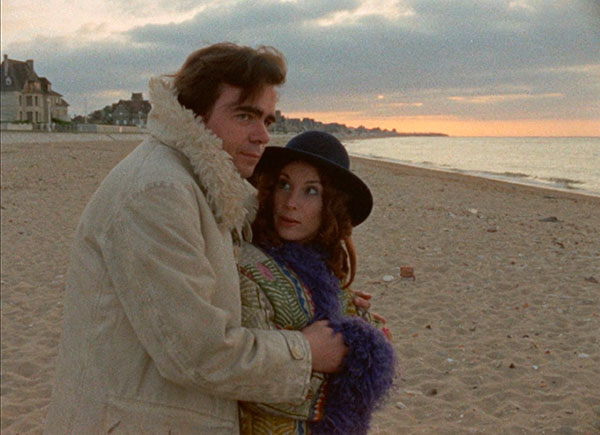
Michael Lonsdale and Bernadette Lafont in Out 1
YT: What also makes Gerard akin to a Rivette character is the sense that he might be a figment of Stephanie’s imagination or a personification of her unconscious. Is that something that was on your mind when you were writing the script?
PF: Absolutely. There was always going to be an impish, elfin quality about Gerard. ‘‘Are you for real?’’ is something Stephanie even asks him at one point. But I made him real for myself, for the purposes of my own sanity. I thought, ‘‘This person exists in the world, and may or may not be lying about who he is.’’
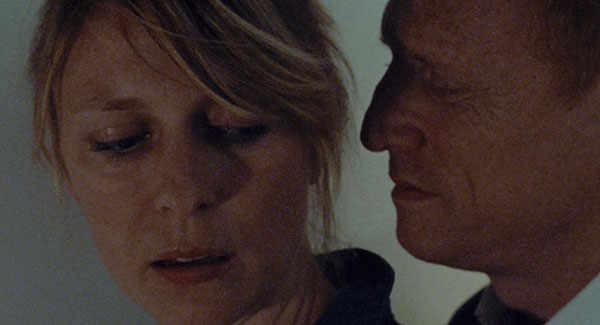
Stephanie Hayes and Scott Shepherd in Slow Machine
YT: How much did you discuss the character with actor Scott Shepherd, who perfectly embodies Gerard’s ambivalence?
PF: Scott came in knowing what to do. Directing him was mainly about calibrating the rhythm of his speech. He and Stephanie spoke a private language. They had their own conspiratorial collaboration that was separate from whatever we were all doing in the room, which was very helpful.
JD: Yeah, it was a huge boon for the film that they knew of each other’s work and had wanted to collaborate for some time.

Scott Shepherd and Stephanie Hayes in Slow Machine
YT: Did you show your actors any of Rivette’s films?
PF: No, because most of them weren’t available in the U.S. yet. Céline and Julie Go Boating has only recently become something you can easily get here—it’s now streaming on Criterion Channel. The movie that we actually made our actors sit down and watch was Godard’s Every Man for Himself [1980], which had just come out on DVD.
JD: There’s a visual naturalism in that film, as in Rivette’s work, that we wanted to give them a sense of.
YT: Slow Machine’s fragmented narrative, which intercuts between different storylines featuring Stephanie, also brings to mind Alain Resnais’ modernist explorations of memory.
PF: When I was writing Slow Machine, I thought of it as a memory piece, and we did talk about Resnais’ movies, especially Muriel [1963] and Je t’aime, je t’aime [1968].
JD: Je t’aime, je t’aime is another favorite of ours that played at the Alliance Française, and was definitely a big editing influence on Slow Machine.
YT: How much of the film’s structure was devised in the editing room?
JD: Our friend Ian Olds, who is also a filmmaker, did the first run of the edit as the screenplay flowed. But it just didn’t work—it seemed confusing and awkward. So we started rearranging the scenes until we could find patterns that would intrigue you as a viewer, and the film would play out in a structural way that made sense. The guiding thread was how memory works—how our brains piece together events from the past, half true, half false.
PF: There were some more traditional scenes that established Stephanie’s character and gave insight into her, which we cut out. That made the movie more coherent in its own particular way.
JD: I was worried about losing the audience’s interest, though. I remember saying, ‘‘Let’s make some sense here around the 30-minute mark.’’ [Laughs] I spoke last night with Milton [Carter, who plays a supporting role in Slow Machine]. He’s just recently seen the film, and even he was like, ‘‘I don’t know what the hell is going on.’’ I said, ‘‘You know, the guy hits his head,’’ and he was like, ‘‘What guy?’’ I said, ‘‘You gotta watch it again.’’ [Laughter]
YT: Tonally and thematically, Slow Machine feels like a cross between Rivette’s and David Lynch’s films, which share many similarities and have drawn comparisons to each other. In 2015, New York’s Film Society of Lincoln Center even organized a dual retrospective of the directors’ work. Is Lynch important to you?
JD: I appreciate Lynch and think he’s awesome as an American director out there. But I’m not a big fan of his work, except for the original two seasons of Twin Peaks [1990-91].
PF: Joe and I never talked about Lynch in relation to Slow Machine, but his work was very formative for me, as for many people from our generation. I’m most interested in the ways in which he plays with doubles and shifting identities in movies like Mulholland Drive [2001] and Inland Empire [2006], which I think are his two best.
What I also find to be a virtue of his films, and that ours hopefully has too, is the sense of a private activity—like a secret, collaborative understanding among the cast and crew that the audience doesn’t entirely have access to. However Lynch works with his actors, whatever vibe he gets them on, is fascinating to me.
YT: There’s a scene in Slow Machine in which Chloë Sevigny, who plays herself, recounts to Stephanie a surreal audition she did for anonymous scarved people in a secluded warehouse. Where did the idea for that sequence come from?
PF: It came from a potentially apocryphal story I’d heard about Catherine Breillat’s directing style, which involved her wearing a scarf over her face so that the actors wouldn’t see her facial expressions. I have no idea if this really happened, but it just felt so aggressive and menacing to me, and stuck with me as an image. In fact, one of the first films I made in graduate school was about a woman who goes to an audition where she has to perform in front of scarved figures.
For me, auditions are such a weird notion—people sit behind a table and judgmentally watch a line of performers do a song and dance. It’s always been a very uncomfortable process to be involved in as a filmmaker. So I wanted to explore that in Slow Machine, and have it take on some metaphysical qualities that weren’t only about how crappy auditions are.
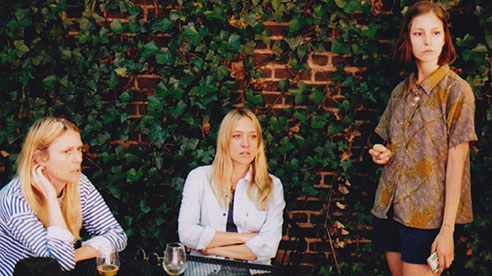
Stephanie Hayes, Chloë Sevigny, and Jes Sweat in Slow Machine
YT: Chloë’s story also evokes Céline and Julie’s trancelike visits to the haunted house in Rivette’s film, where they become spectators of, and later actors in, a period family drama.
PF: Absolutely. I’ve always been interested in stories within stories, and the way the world stops when you suddenly find yourself engrossed in another person’s story is something that does feel trancelike to me.
JD: Trance or the world stopping is your ultimate hope when you go to the movies. The world stops, you’re in this black box with other people—it’s a communal experience.
YT: Are the group scenes in Slow Machine, in which Stephanie hangs out with musician Eleanor Friedberger and her bandmates, indebted to Out 1’s portrayal of the theater troupes?
PF: Definitely. I love Out 1’s durational theater exercises and wish there were more scenes like that in Slow Machine—more real-time documentation of a performance. But we just couldn’t afford to keep the camera rolling for too long [due to the expense of film stock].
I liked the idea that Slow Machine’s characters, like Rivette’s, would have a shared cultural baseline. It’s not like they all went to Bennington College together or something, but they belong to the same milieu in New York.
There’s also a performative way in which characters wield their intelligence at each other in Out 1, as well as in a film like Le Pont du Nord [1981], that I wanted to be a quality of Slow Machine.
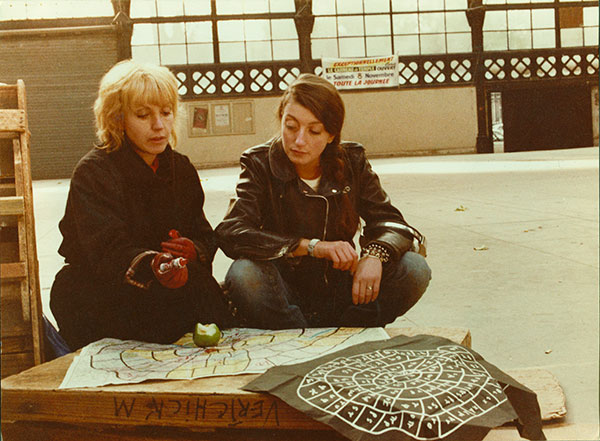
Bulle and Pascale Ogier in Le Pont du Nord (Les Films du Losange)
YT: Rivette intended Le Pont du Nord as a portrait of his era—an era of paranoia and suspicion, but also one in which Paris was being radically altered by urban renewal. It seems to me that Slow Machine is imbued with a similar desire to capture New York’s changing face in the wake of 9/11.
PF: Slow Machine reflects anxieties that both Joe and I feel about what’s happening in the city, and the ways in which the creative work we love is getting professionalized out of existence. It also turned out to be a pretty good COVID movie. It evokes a claustrophobia that I don’t think any of us imagined we were going to experience like we did during lockdown.
JD: People respond to the fact that there’s no picturesque New York in Slow Machine. They’re like, ‘‘Where the hell is the safe house [where Gerard is based]?’’ There’s a sense of New York, but nearly the whole film takes place indoors. In that respect, it’s the reverse of Le Pont du Nord [which was shot almost entirely outdoors in Paris].
Paul wrote the screenplay from an Obama-era, soft-power kind of zone. But things changed so much in the U.S. while we were editing the film. So we hoped that it would achieve an overarching, above-the-fray quality, and it seems to have worked out that way with the audience. No one’s said, ‘‘This is 2014.’’
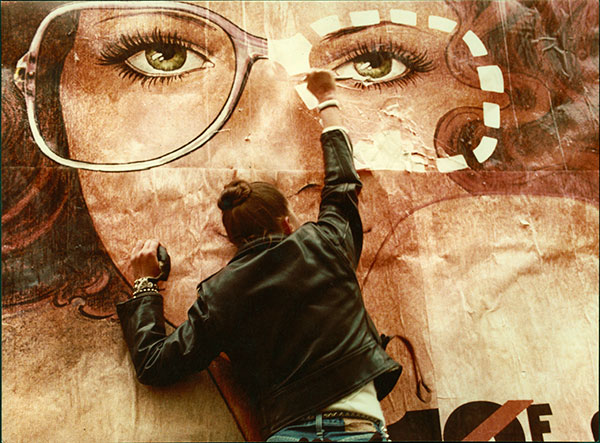
Pascale Ogier in Le Pont du Nord (Les Films du Losange)
YT: There’s definitely a timelessness to the film’s anxious atmosphere, such as when Gerard alludes to a terrorist attack he claims to have protected Stephanie from as ‘‘a deliberately paced collective perishing.’’ That reminded me of a line Pascale Ogier’s character says in Le Pont du Nord: ‘‘Real life is a reign of terror.’’
JD: That’s certainly a Rivette vibe that we take—the playful conspiracy. The danger never manifests itself in a palpable way that you have any real orientation to. It’s just there, and everyone sort of dances around it.
PF: In a way, the conspiracy feels less physically threatening than it does psychologically. Such as it is, the conspiracy perpetuates itself. So worrying about it becomes its engine—which is paranoia. I don’t think we’re concerned about whether someone’s actually going to get blown up when we’re watching Slow Machine or Rivette’s films. We’re just like, ‘‘Are they going to finish the play?’’ [in Out 1.] The stakes are simultaneously very high and kind of casual.
YONCA TALU is a filmmaker and film critic living in Paris. She grew up in Istanbul and graduated from NYU Tisch and the École Normale Supérieure. She is a regular contributor to Film Comment magazine and Metrograph Journal.
dePICTions volume 2 (2022): U.S. vs. … (Un-)American Crossings and Appropriations


Responses